Singhare ka Halwa is a traditional Indian sweet dish made from singhare ka atta (water chestnut flour), typically enjoyed during Hindu fasting days (vrat) such as Navratri, Ekadashi, Mahashivratri, and Krishna Janmashtami. It’s a simple yet soul-satisfying halwa that’s not only nourishing but also quick to prepare using a handful of ingredients that are allowed during fasts.
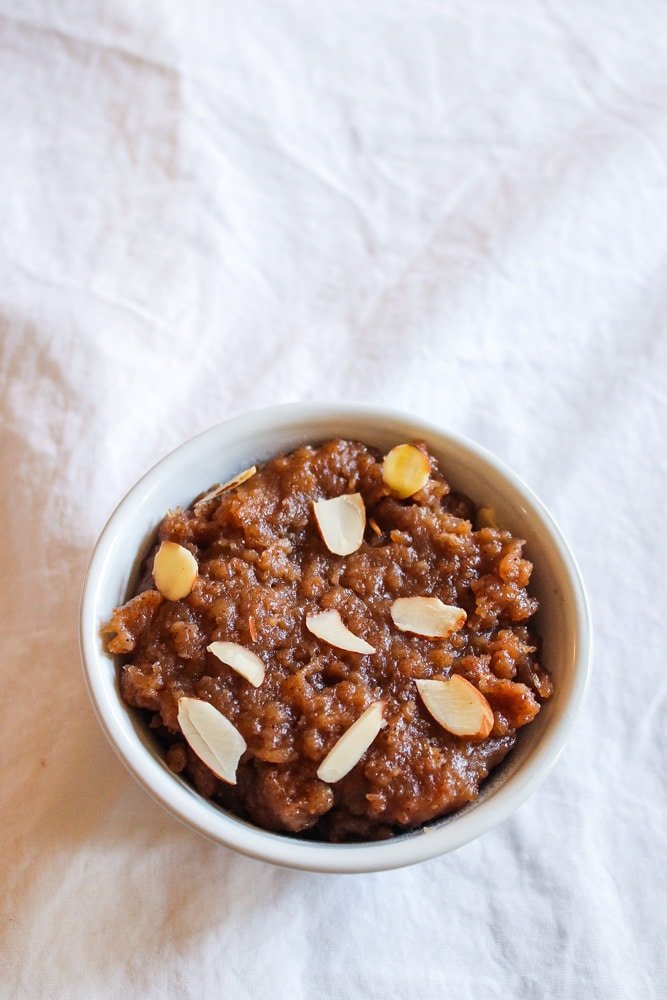
This Singhare Ka Halwa has a soft, melt-in-your-mouth texture, a rich nutty aroma from ghee, and just the right amount of sweetness. Singhare ka atta is gluten-free and known for its cooling and detoxifying properties, making this dish not only festive but also healthy and easy on the stomach.
What makes Singhare ka Halwa truly special is how it combines spiritual purity with indulgent taste — perfect for those observing fasting yet craving a touch of sweetness. It’s also a great way to include energy-boosting foods in your vrat meals.
About This Singhare ka Halwa Recipe
Singhare ka Halwa is one of the easiest and quickest Indian sweets you can prepare, especially during Hindu fasting (vrat) days like Navratri, Ekadashi, or Mahashivratri. The process of making this halwa is quite similar to other Indian halwas or sheeras — the only major difference lies in whether the recipe calls for milk or water as the cooking liquid. In this particular vrat version, water is typically used to keep it light and sattvik (pure).
The secret to achieving a lump-free, smooth texture lies in adding hot water, not cold, to the roasted flour. This one step makes a noticeable difference in the final texture. Also, constant stirring from the very beginning to the end is essential — halwa requires attention and patience. Always keep an eye on it while cooking, as the flour can quickly stick to the pan or develop lumps if left unattended.
Water chestnut flour, or Singhare ka atta, ranks among the few flours people actively use during religious fasts and vrat days. It is naturally gluten-free and considered cooling and nutritious. I love using this flour to create a variety of vrat-friendly dishes at home — from Singhare ki Kadhi and Singhare ki Puri to snacks like sweet potato tikki, farali batata vada, and even sabudana dosa.
For sweetness, I’ve used less sugar in this recipe, as we prefer mildly sweet desserts at home. However, you’re welcome to adjust the quantity based on your taste. Some prefer it rich and sweet, while others enjoy it subtle and comforting — this halwa works well either way!
Ingredients For Singhare Ka Halwa:
- ½ cup Ghee (Clarified Butter): Use pure desi ghee for a rich aroma and authentic taste. Ghee enhances the flavor and gives the halwa its traditional silky texture.
- ½ cup Singhare ka Atta (Water Chestnut Flour): Naturally gluten-free and vrat-friendly flour, essential for this recipe. Roast it well for a nutty aroma.
- 1 cup Boiling Hot Water: Helps in achieving a smooth, lump-free texture. Always use hot water instead of cold.
- ⅓ to ½ cup Sugar: Adjust the sweetness as per your taste. Begin with ⅓ cup of sugar, and adjust the quantity to suit your preferred level of sweetness.
- ⅛ teaspoon Green Cardamom Powder: Adds a fragrant, traditional Indian dessert flavor. Freshly ground cardamom is preferred.
- Chopped Almonds and Cashews (for garnish): Lightly roast or dry them before garnishing for extra crunch and richness.
- 2–3 Raisins: Adds a burst of sweetness and texture when added while the halwa is still warm.
- 1 teaspoon Crushed Makhana: Lightly toasted foxnuts can be added for a vrat-friendly crunch.
- 1 teaspoon Desiccated Coconut: Adds a mild sweetness and enhances the richness of the halwa — optional but delightful.
- A Few Saffron Strands: Soak in a tablespoon of warm milk or water for a beautiful color and aroma — especially for festive servings.
How To Make Singhare Ke Aate Ka Halwa?
1) Heat ghee in a thick-bottomed kadhai or pan over medium flame. As soon as it melts and releases its aroma, add singhare ka atta (water chestnut flour). Stir immediately to blend the flour evenly with the ghee and prevent any dry clumps from forming.
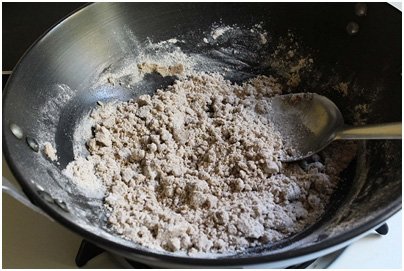
2) Roast the mixture of flour and ghee on medium heat for about 6 to 7 minutes, stirring it continuously with a spatula to ensure it doesn’t stick to the pan or burn. As it cooks, the flour will gradually turn a light golden hue and release a rich, toasty aroma, indicating it’s perfectly roasted.
While roasting the flour, simultaneously bring 1 cup of water to a rolling boil on a separate burner or heat it in the microwave. Ensuring the water is piping hot is crucial, as it helps achieve a smooth, lump-free texture when added to the roasted flour mixture. This hot water is crucial to avoid any lumps when combining.
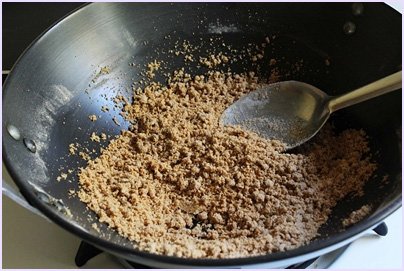
3) Once the flour is evenly roasted and emits a nutty aroma, gently and gradually pour the boiling hot water into the pan in small portions. Stir continuously and briskly as you add the water to prevent any lumps from forming. Take extra care during this step, as the hot mixture tends to bubble and sizzle.Stir constantly to help the flour absorb the water evenly and create a smooth, lump-free halwa. Use only boiling hot water, as lukewarm or room temperature water increases the risk of lumps forming.
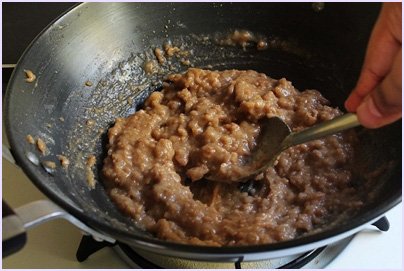
4) Let the water get absorbed by the flour. This takes around 2 minutes. At this stage, add the sugar as per your taste preference. Mix it in thoroughly—this will briefly make the halwa loose and glossy again.
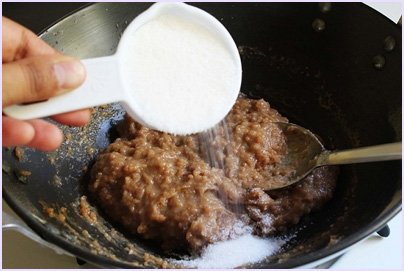
5) Continue stirring as the sugar dissolves. Soon, the mixture will begin to thicken again. The glossy sheen indicates that sugar has melted and integrated well into the halwa.
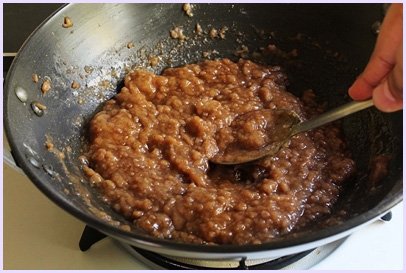
6) Continue to cook the halwa, stirring regularly, until the ghee begins to release from the sides and the mixture starts to come together, pulling away cleanly from the edges of the pan. This indicates that the halwa is fully cooked and has reached the perfect consistency. At this stage, turn off the heat immediately to avoid overcooking. The halwa should now be smooth, slightly glossy, and aromatic.
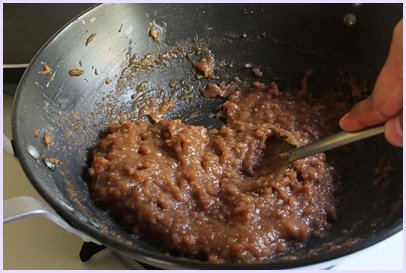
7) Add cardamom powder for a warm, sweet fragrance. Mix it well into the halwa. Then garnish generously with almond slivers or chopped cashews for an added crunch and festive touch.
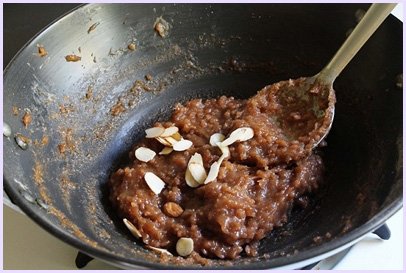
Expert Tips for Perfect Singhare ka Halwa:
- Always use boiling hot water: The temperature of the water plays a critical role in achieving the right texture. Lukewarm or room-temperature water won’t help the flour cook evenly and may cause unpleasant lumps to form. Instead, bring the water to a full rolling boil before adding it to the pan. Pour it slowly and stir vigorously to ensure the flour absorbs it smoothly and uniformly.
- Never leave it unattended: Singhare ka atta tends to cook very quickly, especially once it starts absorbing ghee and water. If left unattended, it can stick to the bottom of the pan and burn, ruining the flavor. Stir continuously and stay focused throughout the process. It’s a quick-cooking recipe, so a few minutes of full attention go a long way.
- Use fresh flour only: Always check the freshness of your Singhare ka atta before using it. Water chestnut flour tends to have a limited shelf life, and if it’s not fresh, it can negatively affect the flavor of your halwa.
- Stale flour often develops an unpleasant, musty aroma and may impart a bitter aftertaste to the dish. If you notice any odd smell or unusual clumping in the flour, it’s best to discard it and use a freshly purchased batch for optimal taste and quality.
- Adjust sugar as per your taste: Start by adding ⅓ cup of sugar to the halwa, then taste it and adjust according to your preference. Some enjoy a mildly sweet version, while others prefer a richer dessert. Let the natural sweetness of cardamom, saffron, and dry fruits help balance the flavor as you customize the sweetness to your liking.
- Add natural sweeteners: To enhance both flavor and nutrition, consider adding finely chopped dates or raisins during the final stage. These not only introduce subtle sweetness but also create delightful bursts of texture in every bite.

Variations Of Singhare Ka Halwa:
1. Kesar Singhare Halwa (Saffron-Infused Delight):
Soak a few saffron strands in a tablespoon of warm milk for 5 to 10 minutes to boost the halwa’s richness and aroma. As the halwa nears completion and the ghee starts separating from the sides, pour in the saffron-infused milk and stir gently. This step gives the halwa a warm golden color and a delicate fragrance—ideal for festive occasions. Finish by topping it with slivered almonds or dried rose petals for a luxurious and elegant presentation.
2. Dry Fruit-Loaded Singhare Halwa (Rich & Nutty):
If you enjoy texture and richness, enhance your halwa by mixing in a generous handful of dry fruits. Once the sugar dissolves completely, add chopped pistachios, cashews, raisins, and finely chopped dates. Let the dates naturally sweeten the halwa while the nuts bring a delightful crunch. For a deeper flavor, lightly roast the dry fruits in ghee before adding them. This version not only boosts the taste but also adds nutrition, making it perfect for vrat days or as a wholesome post-meal dessert.
3. Coconut Singhare Halwa (Tropical Fusion):
Introduce a coastal or tropical flavor twist by adding 2–3 tablespoons of freshly grated coconut while roasting the flour. For a richer version, you can even replace part of the water with coconut milk. The subtle sweetness and aroma of coconut beautifully complement the earthy taste of singhare ka atta. This variation is creamy, mildly sweet, and truly comforting. Garnish with toasted coconut flakes for added appeal.
Each of these creative spins adds a new dimension to the traditional singhare ka halwa, making it suitable for different moods, festivals, and tastes.
